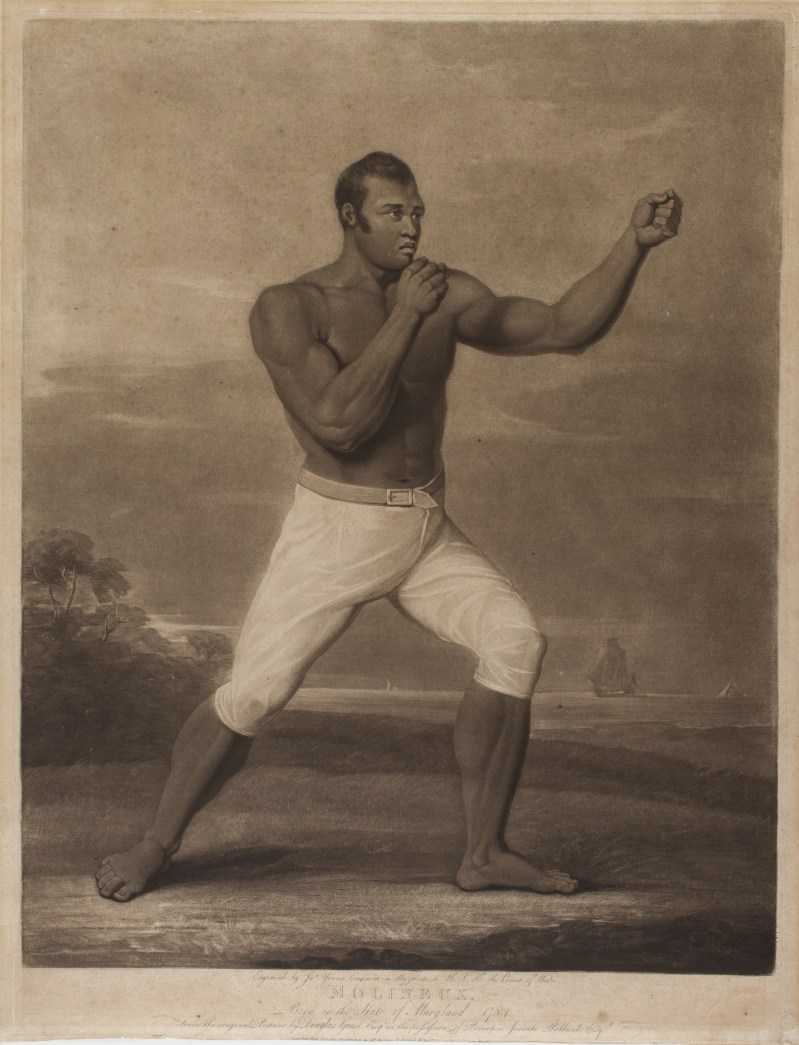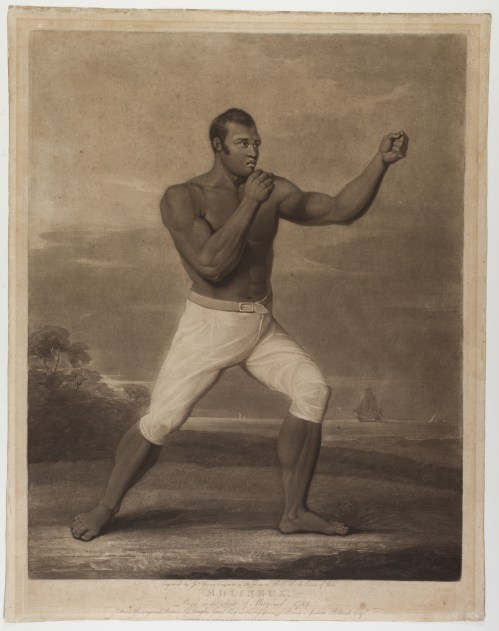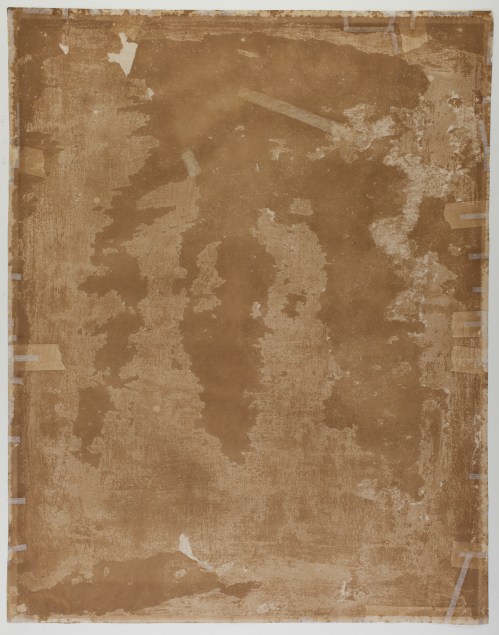John YOUNG: Molineux - ca. 1809/1811
SOLD
Mezzotint, 597 x 470 mm (sheet). Chaloner Smith 55.
Very fine impression printed on laid paper. Small margins on three sides, trimmed through the address bottom. Yellowing of the sheet, strong foxing of the reverse with traces of old glue. A few foxmarks recto. Six short restored tears in the margins and three small filled-in areas along the edges of the sheet. Three tiny pinholes retouched near the right foot of the boxer.
Scarce print.
This impression was sold at Sotheby’s, New York, on 26 October 1990 (catalogue no. 76, illustrated).
Title and caption engraved bottom: Engraved by Jno. Young, Engraver in Mezzotinto, to H.R.H. the Prince of Wales. / MOLINEUX, / Born in the State of Maryland. 1784. / From the original Picture by Douglas Guest Esqr. in the pofsefsion of Procopio Jacinto Pollock Esqr. / London, Pub. for the Proprietor, by Mr Molteno, Pall Mall, & Mefsrs. Colnaghi, Cockspur Street
As it is indicated, John Young made this portrait of Thomas Molineux, a famous black American boxer, after a painting by the English painter Douglas Thomas Guest (1781-1845) probably around 1810. John Young « was appointed engraver in mezzotinto to the Prince of Wales in 1789; keeper to the British Institution, about 1813; and was Honorary Secretary to the Artists' Benevolent Fund. » (John Chaloner Smith, British Mezzotinto Portraits, 1883, 4th part. Young, pp. 1622-1646). Young also engraved some other portraits of bare fist pugilists in boxing attitude, including « the Gentleman Boxer » Richard Humphrey « The Celebrated Boxer who never was conquered », after a picture by John Hoppner (op.cit. p. 1634) and « The match between John Broughton vs George Stevenson" after John Hamilton Mortimer (1741 - 1779), an impression of which was sold in 2019 by Yves Siebers Auktionen GmbH, Stuttgart, Germany for 5000 €.
Douglas Thomas Guest painted full-length portraits of two other boxers, Thomas Cribb and Thomas Belcher. The painter and caricaturist Richard Dighton (1795-1880) also made in 1812 a color etching titled: Tom Molineaux. He had already made in 1810 a color etching representing another boxing champion, Bill Richmond, in a posture similar to that of Molineux in Young's mezzotint.
Thomas Molineux is represented here in a fighting posture, standing on a deserted shore, his athletic body erected against a dark sky, his fist raised. The bare-chested athlete, dressed in combat outfit, white breeches and belt, dominates the seashore where a galleon ready to dock could evoke the landing on the Atlantic coast of cargoes of slaves imported from Africa, many of whom were employed on the tobacco plantations of Maryland and Virginia.
Thomas Molineux was said to have been a slave on these plantations. Born in 1784 in the state of Maryland, he belonged to a wealthy owner named Molineux who noticed his athletic physique and had him trained in bare-knuckle boxing. The young Molineux competed against other slaves in fights organized by wealthy owners and won many victories. It is said that the planter's son offered him $500 and freedom if he won a fight with $100,000 at stake. Having won this fight and his freedom, Thomas Molineux went to New York to box and win prizes. After a series of victorious bouts allowed him to declare himself the champion of the United States in 1809, it is known that he embarked that same year for London, where he was trained by a great boxing champion, a freed former slave, Bill Richmond, knows as "The Black Terror". According to boxing historian Clay Mole, Richmond was "the first black boxer to gain international recognition". Molineux won several important fights in 1810, including one against champion Tom Tough, a former Navy veteran whom he knocked out in the 8th round. He was however unlucky in his two encounters with world champion Thomas Cribb, in 1810 and 1811: he lost the first fight in the 14th round (some say 33rd, others 35th) after coming close to winning, and the second fight with a broken jaw in the 11th round. His career having ended in 1815 with a defeat, Molineux ended his life without money in Ireland, in Galway, where he died in 1818.
Such is the legend of Thomas Molineux, known as "The Moor" or "The Virginian Slave", whose birthplace (Maryland or Virginia) and exact spelling of his name (Molineux, Molineaux, or Molyneux) are not known for certain. A boxing historian, Christopher James Shelton, doubts that Molineux was ever a slave. He also doubts that a $100,000 bet could have been made at that time in the United States on a bare-knuckle boxing match. One can consult the page of the site The Cyber Boxing Zone Encyclopedia where James Shelton tries to unravel the legend of "Tom Molineaux" and reproduces an article from an English newspaper of the time (Sporting Magazine) which relates in detail one of his fights.
References: John Chaloner Smith, British Mezzotinto Portraits, 1883, 4th part. Young, pp. 1622-1646; Clay Moyle Thomas Molyneux (1784-1818), BlackPast.org. african-american-history (2008, May 23); Fred Henning, Fights For The Championship, Volume II (London: Licensed Victuallers’ Gazette, 1899) and Henry Downes Miles, Pugilistica, The History of British Boxing Volume I (London: Weldon & Co., 1880); Christopher James Shelton, Thomas "Tom" Molineaux, The Cyber Boxing Zone Encyclopedia.





